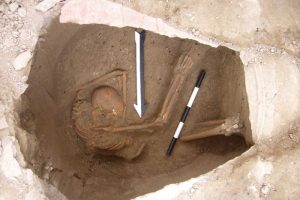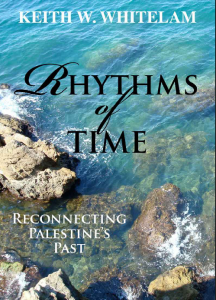
Through the ABC news article, Canaanites survived Biblical ‘slaughter’, ancient DNA shows I was led to The American Journal of Human Genetics open access article, Continuity and Admixture in the Last Five Millennia of Levantine History from Ancient Canaanite and Present-Day Lebanese Genome Sequences, to read that the modern population of Lebanon contains the DNA of the ancient Canaanites.
The ABC article sums up for the TL;DR folk:
- DNA reveals that modern Lebanese are direct descendants of ancient Canaanites
- Despite tumultuous history, there has been substantial genetic continuity in the Near East across the past 3,000 to 4,000 years
- European additions to Lebanese ancestry occurred around 3,750-2,170 years ago
- Study also provides clues about ancient Phoenicians
 Immediately I recalled Keith Whitelam’s book, Rhythms of Time, and I would suggest that the above DNA research does add support to his thesis that I discussed in 2015 at The Rhythms of Palestine’s History. (See also The Dark Resurgence of Biblical History.)
Immediately I recalled Keith Whitelam’s book, Rhythms of Time, and I would suggest that the above DNA research does add support to his thesis that I discussed in 2015 at The Rhythms of Palestine’s History. (See also The Dark Resurgence of Biblical History.)
Here’s the abstract from the open access article:
The Canaanites inhabited the Levant region during the Bronze Age and established a culture that became influential in the Near East and beyond. However, the Canaanites, unlike most other ancient Near Easterners of this period, left few surviving textual records and thus their origin and relationship to ancient and present-day populations remain unclear. In this study, we sequenced five whole genomes from ∼3,700-year-old individuals from the city of Sidon, a major Canaanite city-state on the Eastern Mediterranean coast. We also sequenced the genomes of 99 individuals from present-day Lebanon to catalog modern Levantine genetic diversity. We find that a Bronze Age Canaanite-related ancestry was widespread in the region, shared among urban populations inhabiting the coast (Sidon) and inland populations (Jordan) who likely lived in farming societies or were pastoral nomads. This Canaanite-related ancestry derived from mixture between local Neolithic populations and eastern migrants genetically related to Chalcolithic Iranians. We estimate, using linkage-disequilibrium decay patterns, that admixture occurred 6,600–3,550 years ago, coinciding with recorded massive population movements in Mesopotamia during the mid-Holocene. We show that present-day Lebanese derive most of their ancestry from a Canaanite-related population, which therefore implies substantial genetic continuity in the Levant since at least the Bronze Age. In addition, we find Eurasian ancestry in the Lebanese not present in Bronze Age or earlier Levantines. We estimate that this Eurasian ancestry arrived in the Levant around 3,750–2,170 years ago during a period of successive conquests by distant populations. (The bolding is mine.)
Oh the implications, the questions……
If you enjoyed this post, please consider donating to Vridar. Thanks!

Would be interesting to see comparisons with Israeli and Palestinian populations.
Ashkenaz (most modern day Jewry) are 98.5% European as this sample of 3 well known American Ashkenaz will show http://www.pbs.org/weta/finding-your-roots/blog/ashkenazi-jewish-dna-potential-piece-together-shattered-family-branches/
It seems that science can be corrosive too poorly held beliefs.
This study would seem to prevail against the theory that, as the Persians had a policy of mixing up their conquest populations, the “returning exiles” under Ezra and Nehemiah were not “returning” Israelites exclusively (or at all), but settlers from all over the Persian empire. It would seem that actually there is a genetically stable population in the region going back thousands of years.
Levantines know their history.
“As a descendant of Canaanite Shepherds, we Nebatean Canaanites took our mission of telling it to the world seriously. While we adopted different newer religions & rulers came & went, we remained the people of the ancient land & we were & remain pioneers. We were the first to develop: law, astronomy, math, & shipping, agriculture (hence the designations of fertile crescent & land of milk & honey), first to domesticate plants & animals, an alphabet – proto Aramaic alphabet evolved into the Arabic & Hebrew here in Canaan.” Palestinian Prof Mazin Qumsiyeh